We received a letter from a reader who was confused by the differences in point of impact for various gun and ammunition combinations. He had been doing some testing with his collection of fixed sight revolvers and was having a difficult time understanding why they were printing at different elevations, even when shooting the same ammo.
He’s not alone. Sight regulation is a common problem for handgun shooters, and a lot of them haven’t had the issue clearly explained to them, so there’s some confusion out there. This makes it an excellent topic for us to explore, so let’s take a little dive into the world of handgun sight regulation and see if we can peel back this onion.
BACK TO BASICS
The first place to start is with a little geometry. When you look at someone shooting a handgun, it looks like they’re holding it with the barrel parallel to the ground, but that’s not the case. In truth, the barrel of the handgun is angled downwards, ever so slightly, when the sights are aligned on target.
Why? Well, because the recoil of the gun is going to raise the barrel up after it’s fired, and we have to account for that before we pull the trigger. If we aligned the gun in a way that the bore was perfectly level with the spot on the target where we wanted the bullet to strike, the bullet would strike high when the gun was fired. This is because the barrel is rising from the recoil force as the bullet races down the barrel. By the time the bullet exits the barrel, the muzzle has been lifted above its preignition starting point, sending the bullet on its way at an inclined angle.
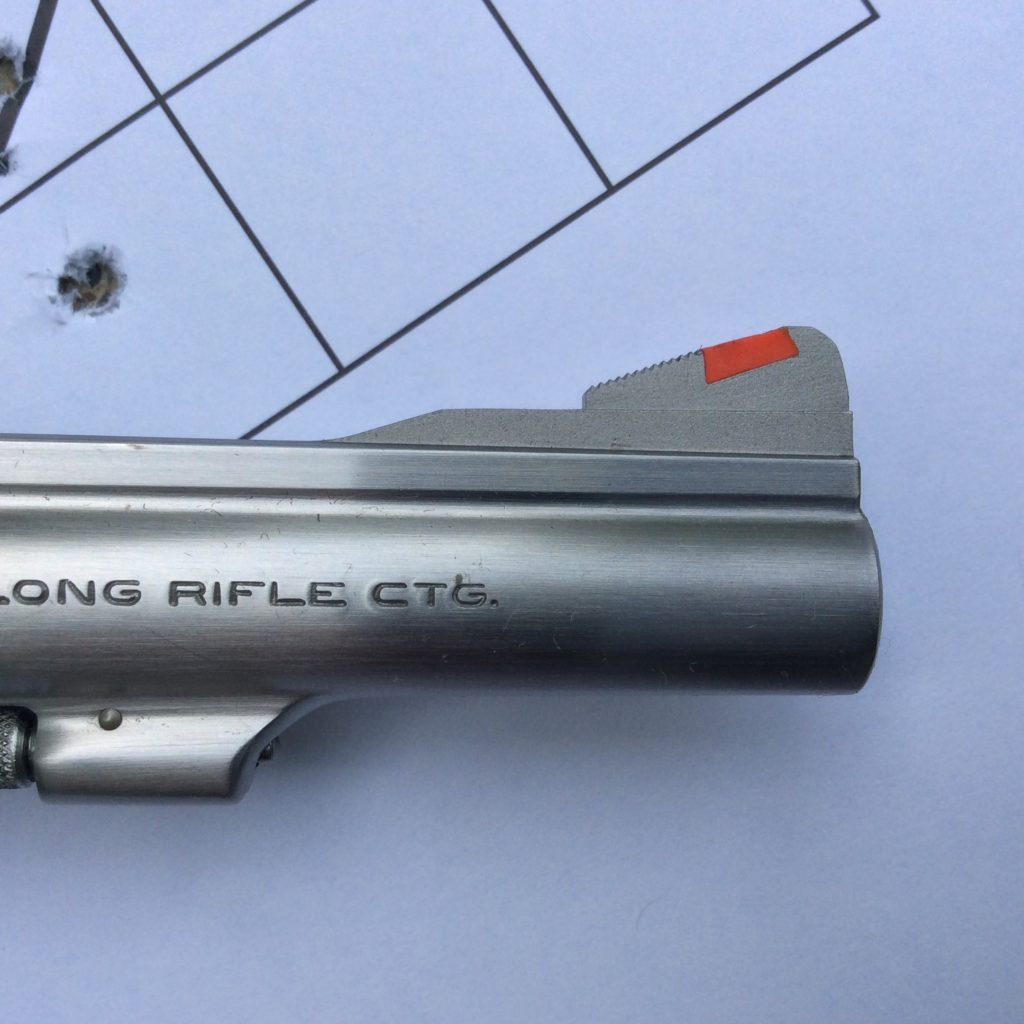
To account for this, gun manufacturers build their handguns with a front sight that is taller than the rear sight. With a taller front sight, the shooter is forced to lower the muzzle at a slight downward angle in order to obtain the proper sight alignment, with the top of the front sight level with the top of the rear sight. When the shooter aligns the sights in this manner (“sight alignment”), and puts them on the target in the right place (“sight picture”), the barrel is pointing below the spot on the target where the sights are indexed. Once the cartridge fires, the recoil forces lift the barrel, and if all the variables are properly regulated, the bullet will fly out the end of the barrel at just the right moment during the barrel’s upwards climb, to ensure it goes where you want it to.(1)
Voila! You just shot a bullseye.
THOSE NASTY DETAILS
Remember those “properly regulated” variables that I mentioned? Well, that’s where things can get interesting. It helps to think of the firing cycle as a math equation with a lot of different inputs. If you enter the same numbers into the equation every time, you’ll get the same result over and over. However, if you change even one of the values, you’ll get a different answer. If you change a lot of them, your answer will change again, and may not be anywhere close to your original one.
In terms of sight regulation, there’s a lot of variables which could change your math equation, and give you a solution that sends your bullet higher or lower than you desire on the target. Your sight picture (“point of aim,” or POA) might look the same, but your bullets will shoot to a different elevation (“point of impact,” or POI) as a result of these changing inputs. Let’s take a look at some of them, in no particular order.
DISTANCE
Our complex math formula is only good for one distance, assuming everything else remains the same. Since our bullet leaves the barrel at an angle to the horizontal, the effect of that angle changes as a function of the distance to the target. At shorter ranges, the resulting change in elevation is less for the same angle, and at longer ranges, it is more. So, if your gun is sighted in for 25 yards and nothing else changes, it will shoot lower than your POA at 10 yards, and will shoot higher than your POA at 40 yards.
There’s one variable that always changes though, and that’s the effect of gravity. We’re fortunate that this rock we live on has a gravitational pull that keeps us grounded, but it does play its tricks on us when we shoot. From the moment our bullet leaves the barrel, gravity is doing its best to pull it down towards the Earth. So, when distances increase, gravity has more time to work on our bullet, and the bullet’s trajectory will be affected more.
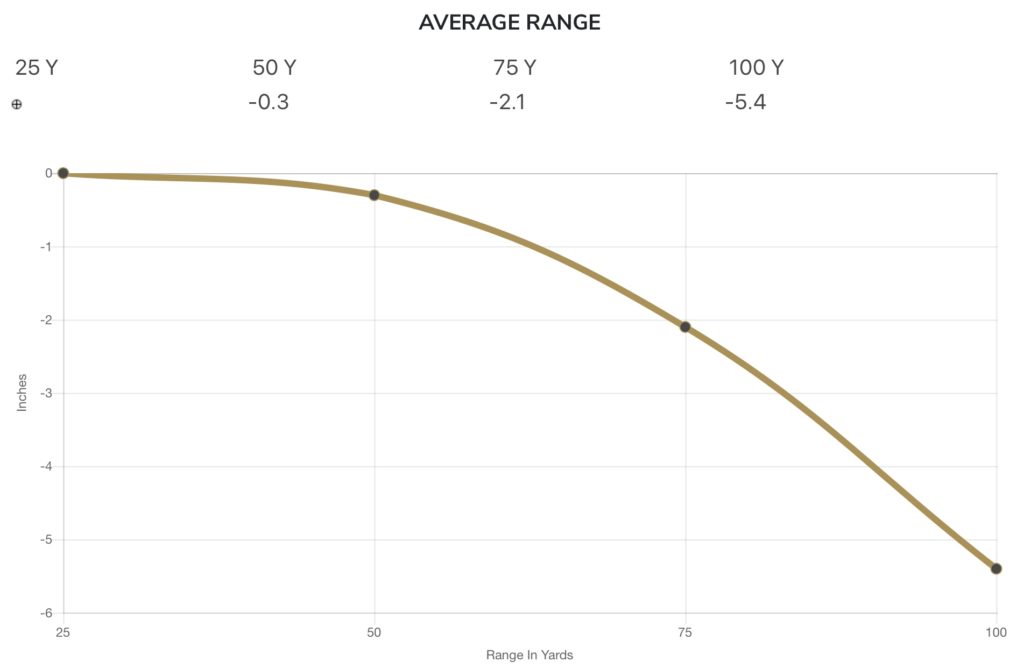 That gravity thing at work. This is a trajectory for the Federal C357B load—a .357 Magnum, 125 grain JHP. Image from Federal Ammunition. https://www.federalpremium.com/ballistics-calculator
That gravity thing at work. This is a trajectory for the Federal C357B load—a .357 Magnum, 125 grain JHP. Image from Federal Ammunition. https://www.federalpremium.com/ballistics-calculator
At short distances, the effect of gravity is negligible enough that we mostly ignore it, but when we try to stretch a handgun out to longer ranges (as in some of the silhouette games or extreme hunting situations), the effect of gravity becomes so significant that we have to raise the barrel’s preignition starting point in order to get rounds on target. We do this by changing the height of the sights (on adjustable sighted guns, or guns with replaceable sights) or by holding over (on guns with fixed sights that cannot be changed). At some point, the barrel will no longer start at a declined angle from the horizontal, but will instead start with an inclined angle from the horizontal, to ensure the arcing trajectory needed to fight the effects of gravity on the way to the distant target.
SIGHT HEIGHT
We’ve already touched on this, but changing the height of your sights above the bore line will have an effect on POI. Consider a gun that has a taller front sight than normal. When you get your perfect sight alignment, with the top edge of the front sight level with the top edge of the rear sight, your barrel will be pointed downwards at a greater angle than it would on a gun with a shorter front sight. All else being equal, your rounds will impact lower on your target than you were expecting, because the bullet will leave the barrel while it’s depressed at a lower angle than usual.
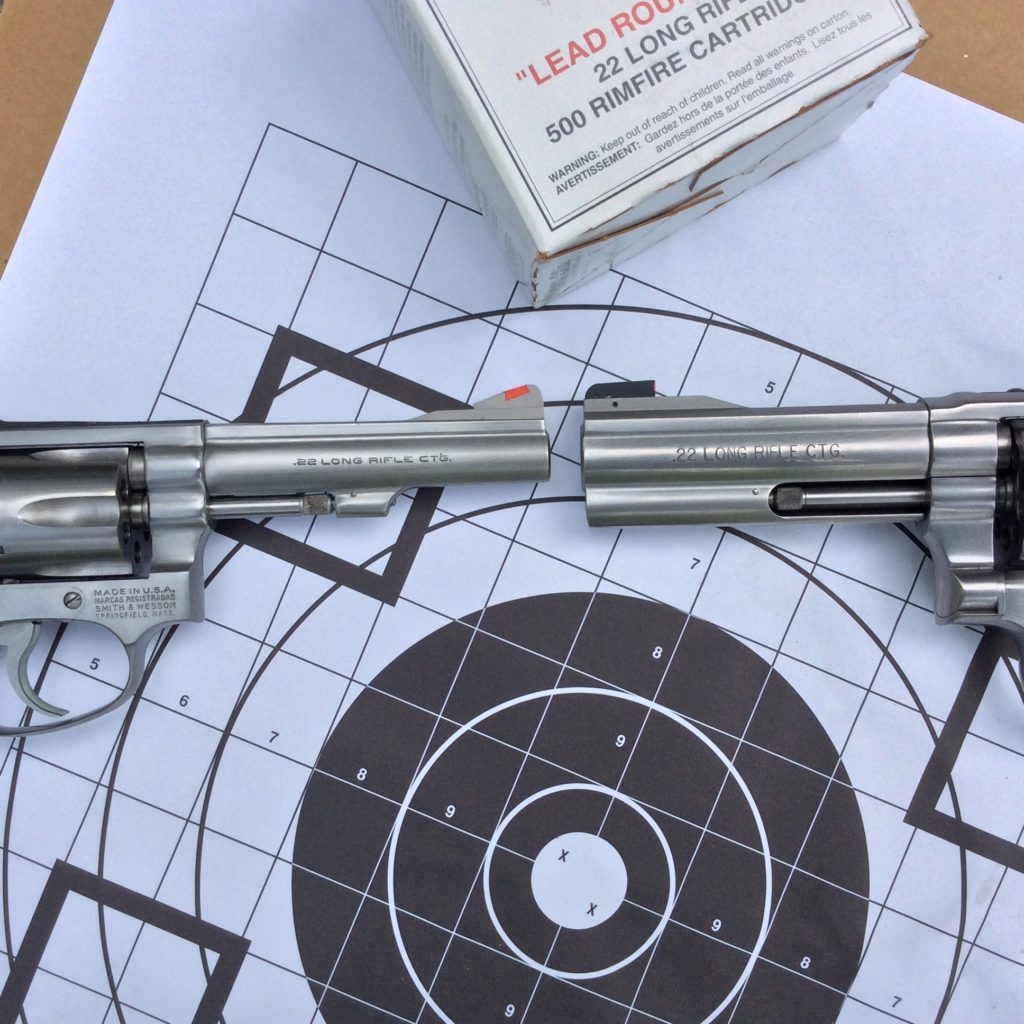 These guns are both adjustable sight .22s with 4” barrels from S&W, but one has a front sight that is taller than the other. That will definitely change POI for each gun, until the rear sights are adjusted to accomodate.
These guns are both adjustable sight .22s with 4” barrels from S&W, but one has a front sight that is taller than the other. That will definitely change POI for each gun, until the rear sights are adjusted to accomodate.
We see this frequently on guns with special sight options, like fiber optics or night sights. Front sights that are equipped with fiber optics or tritium lamps tend to be taller than normal, to make room to mount those light sources. If the rear sight isn’t modified accordingly (and they never seem to be, especially on fixed-sight guns), the taller front sight will make the gun shoot lower than the same gun equipped with shorter, standard height sights. This was likely a player on the Kimber K6s DC that we reviewed in these pages before—the tritium-equipped front sight was too tall for the gun, which made it shoot below POA inside its normal envelope. Justin encountered the same thing on his S&W 640 Pro, with it’s taller than usual front sight.
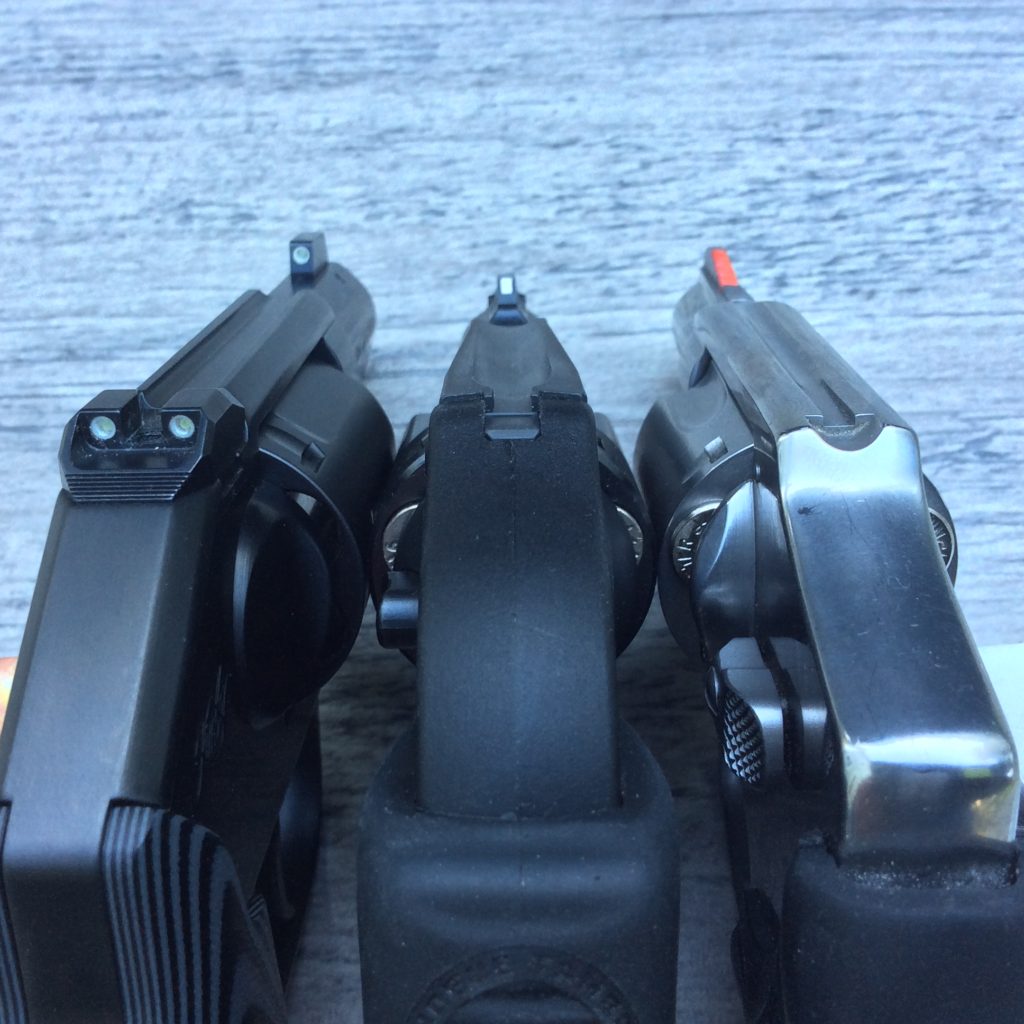 The tall front sight of the Kimber, at far left, made it print lower than other guns in the same class with shorter posts.
The tall front sight of the Kimber, at far left, made it print lower than other guns in the same class with shorter posts.
THE BULLET
The bullet’s characteristics can have a huge effect on where it prints in relation to the sights. If we restrict our focus to short ranges, the primary factors to consider are weight and velocity.
Let’s start with velocity. A fast bullet will exit the barrel more quickly than a slow one, which means that it will exit earlier in the barrel’s rise under recoil. The result is a bullet that hits lower on the target, all else being equal. The reverse is true for a slower bullet than normal, which can print higher.
Weight also affects POI. A heavier projectile can impart more recoil force when the cartridge is fired, which will increase the amount of barrel rise. This potentially results in a bullet that hits above the POA, all else being equal, with the reverse happening for a lightweight bullet that doesn’t move the gun as much after ignition.
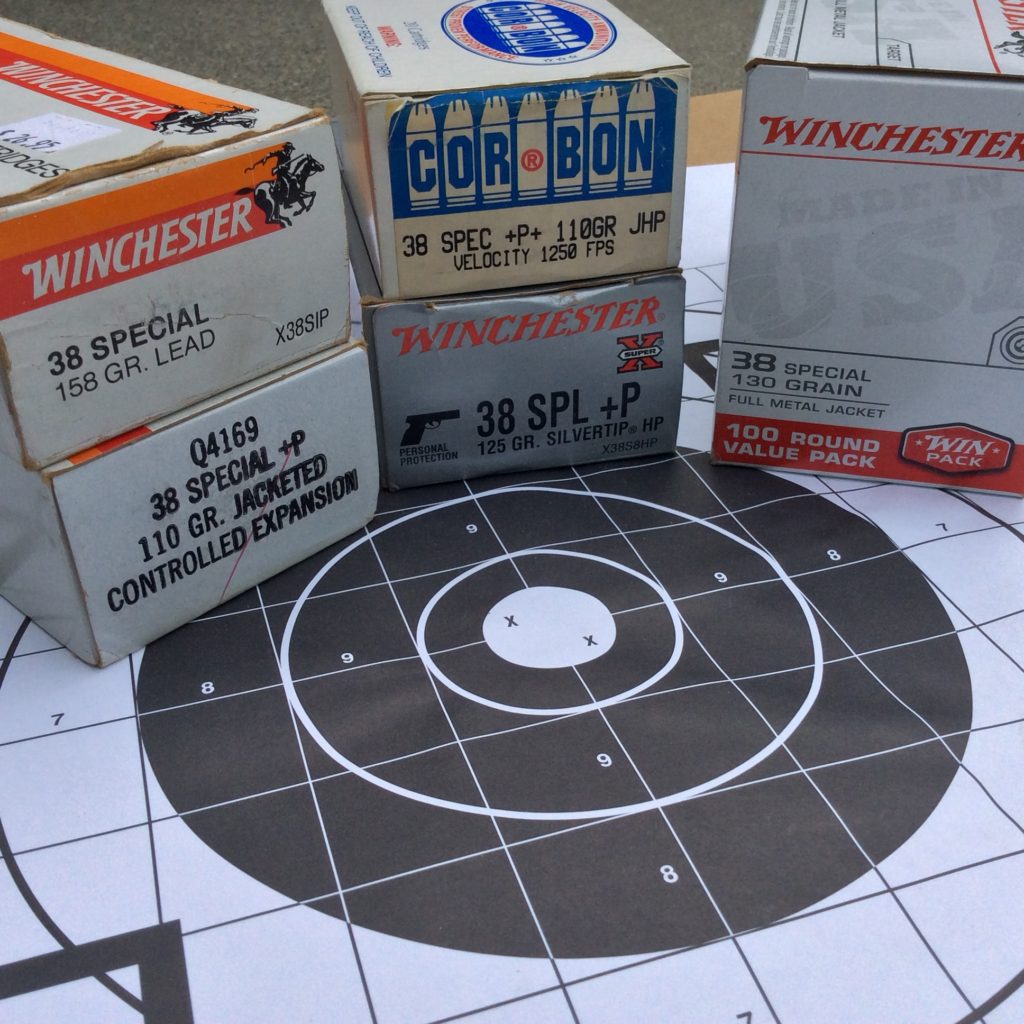 They’re all .38 Specials, but differences in bullet weight and velocity will definitely result in point of impact shifts on the target.
They’re all .38 Specials, but differences in bullet weight and velocity will definitely result in point of impact shifts on the target.
The rub is that bullet weight and velocity are often linked to each other, and it’s hard to know how a high-speed, lightweight bullet will compare to a slow-speed, heavyweight. The amount of recoil energy created by these different rounds can change dramatically with changes in weight or velocity, and although you could mathematically estimate the scale of the change, in practical terms you just have to shoot it to know for sure.
When we start talking about longer ranges, the shape, dimensions, and weight distribution of the bullet (which combine to create its ballistic coefficient) have a big influence on performance, but none of these things matter much at the short distances most handguns are fired (generously assumed to be within 25 yards).
BARREL LENGTh
The length of the launch tube has several influences on where a bullet will print on paper. To begin with, longer barrels usually come with a longer sight radius. Because the front sight is located farther away from the rear sight, the barrel is depressed at a shallower angle to the horizontal when the sights are aligned, than they would be on a shorter gun with a front sight of the same height.
We see this when a manufacturer makes the same gun in multiple barrel lengths, but uses the same front sight blade for each of them. If you’re shooting a snubby with a 2” barrel that has the same front sight as the 6” version of the same gun, then your snubby is going to shoot to a lower POI with the same POA, all else being equal.
 The 2.5” Combat Magnum Stainless wears the same sights as the longer, 4” version. That’s going to result in POI shifts on target.
The 2.5” Combat Magnum Stainless wears the same sights as the longer, 4” version. That’s going to result in POI shifts on target.
Barrel length also matters because the bullet spends longer in the bore before it finally comes out. We call the interval between ignition and when the bullet exits the bore “dwell time,” and all else being equal, if the bullet has more dwell time, it will often shoot to a higher POI because the barrel has had more time to rise in recoil.
At longer ranges, the barrel length might become significant because of its influence on the velocity of the bullet. Honestly, an extra inch of barrel length doesn’t tend to increase handgun velocities very much (it varies, but a general rule of thumb is about 25-50 fps), but when you’re shooting at the longer distances, it might make a little bit of difference. It won’t matter up close though.
WEIGHT
The gun’s weight is a player in how the gun will recoil. All else being equal, a heavier gun will be disturbed less by recoil forces than a lighter gun, so the bullet will typically exit the barrel after less rise. This is another way that a longer barrel can make a difference in POI, but barrel profile can be just as important too. A heavy, bull barrel will dampen the effects of recoil better than a “pencil” barrel, even if the pencil barrel is a bit longer.
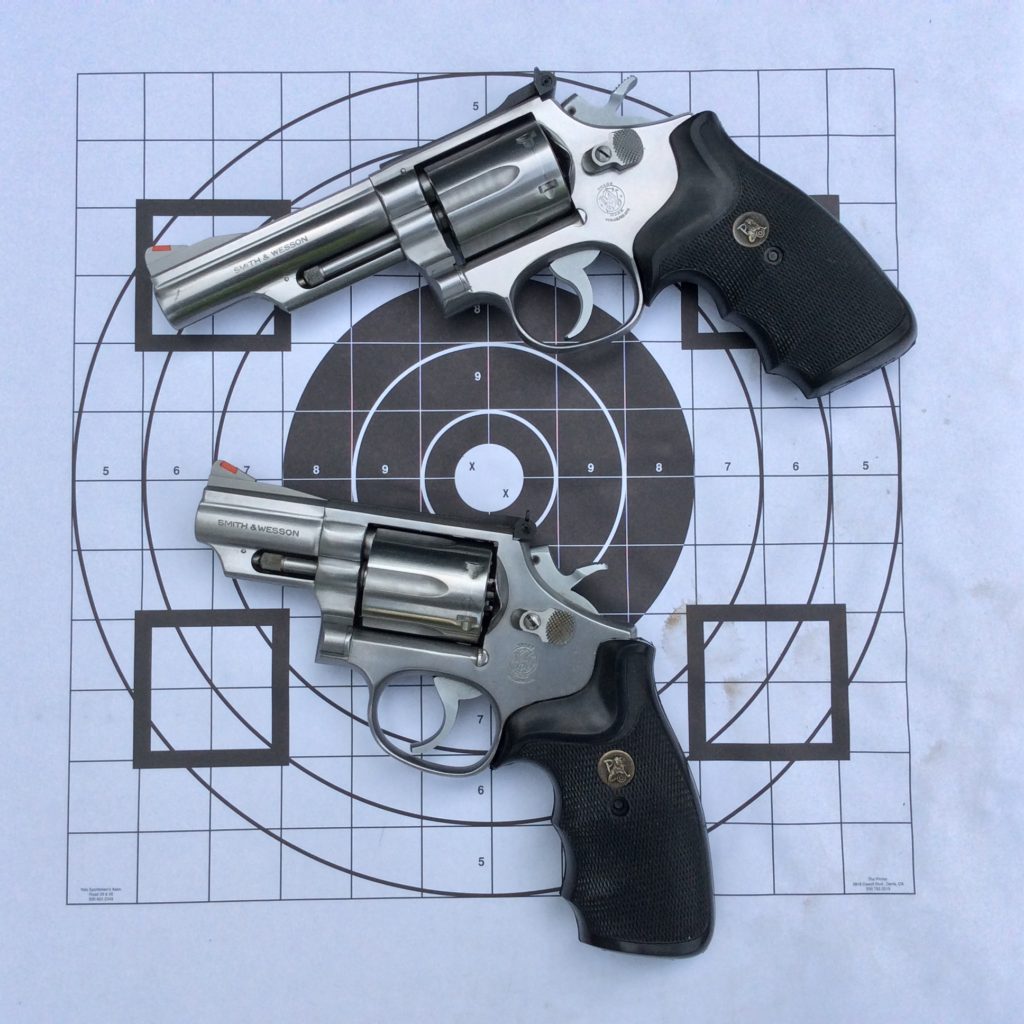 The extra weight of the 4” gun will change how it recoils and how much the muzzle will rise, thereby dictating a change in sight adjustment.
The extra weight of the 4” gun will change how it recoils and how much the muzzle will rise, thereby dictating a change in sight adjustment.
It’s all about how much material you have hanging out there and the distance it’s located from the support, so expect that your aluminum-framed Airweight will shoot differently than your all-steel version, even if they share the same sights and barrel length. So might your “unobtanium” large frame revolver, in comparison to a smaller, shorter gun of about the same weight.
THE PLATFORM
“The platform” is essentially YOU. We’re talking about all the elements of the physical apparatus that hold the gun on target. So, if there’s something that changes in the way the gun is supported, you can expect to see the results on paper. For example, if you’ve got two identical guns, firing identical loads, but the grips on one fit your hand better than the other and give you greater control of the gun, then you can expect they might shoot to different points of impact. Same for square versus round butt guns, as they might move in your hand differently, and therefore track differently, under recoil.
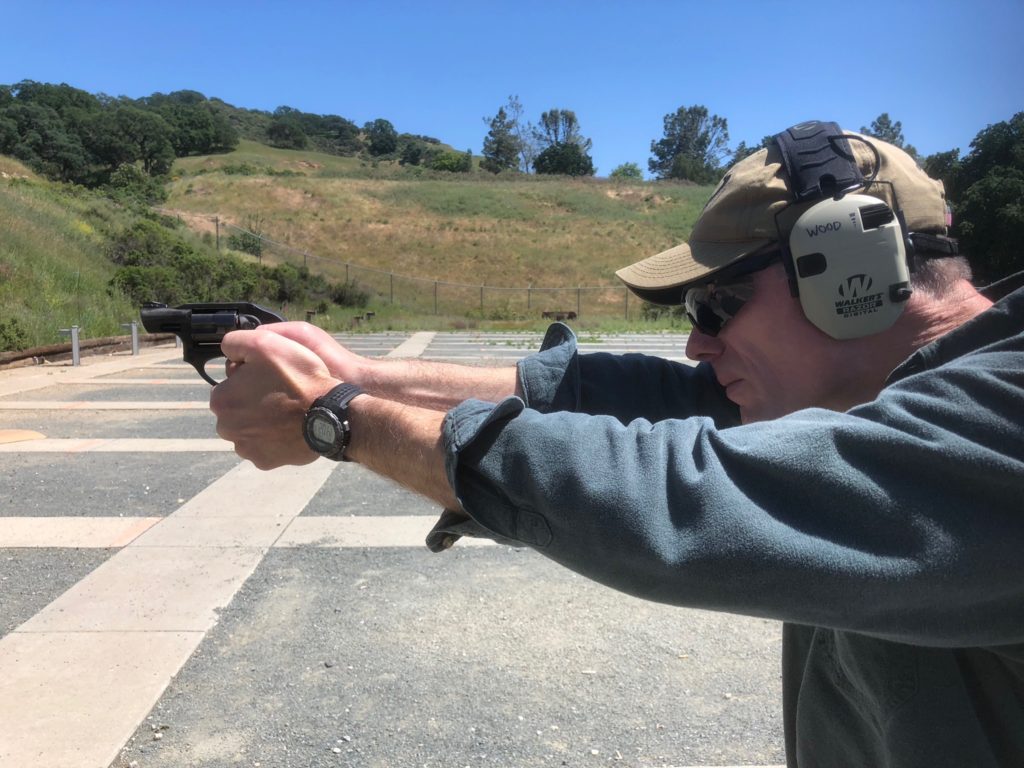 The nut behind the trigger is a critical part to adjust for best—and consistent—results.
The nut behind the trigger is a critical part to adjust for best—and consistent—results.
Similarly, if you’re comparing your groups that are fired with two hands to those fired with one, or from sandbags on the bench versus unsupported standing, you can expect to find differences in the POI. The gun will simply move differently under recoil in those scenarios, with corresponding changes to your POI.
One indirect issue with the platform is how we see the sights. Sometimes the ambient lighting, or even the type of finish or texture on a front sight, can change the way we see it. In example, shooting your gun on an indoor range may result in a POI change compared to shooting outdoors, because of how the available light illuminates your front sight. Similarly, a front sight with a nickel or smooth finish might reflect the light differently enough from a black or serrated sight to cause a change of impact. Let’s face it—the bullet will shoot where the barrel sends it, and the barrel is positioned by our sight alignment, so anything that can influence our sight alignment may also influence the POI.
THE QUANDARY
I’ve been repeating the phrase “all else being equal,” a lot in these explanations as a way to restrict our focus to one variable at a time. The problem with that, is that all of these variables act in concert with each other at the same time, and combine to influence the POI of your bullet.
Consider, for example, the effect of changing from one load to the next in your snub revolver. Let’s say you shoot an all-steel snub with a 2” barrel, which you normally load with a 158 grain, +P lead hollowpoint that clocks about 790 fps out of the short tube. If you suddenly decide that you want to start shooting a 90 grain, +P screamer that travels 1,350 fps out of the same gun, what will that do to your POI?
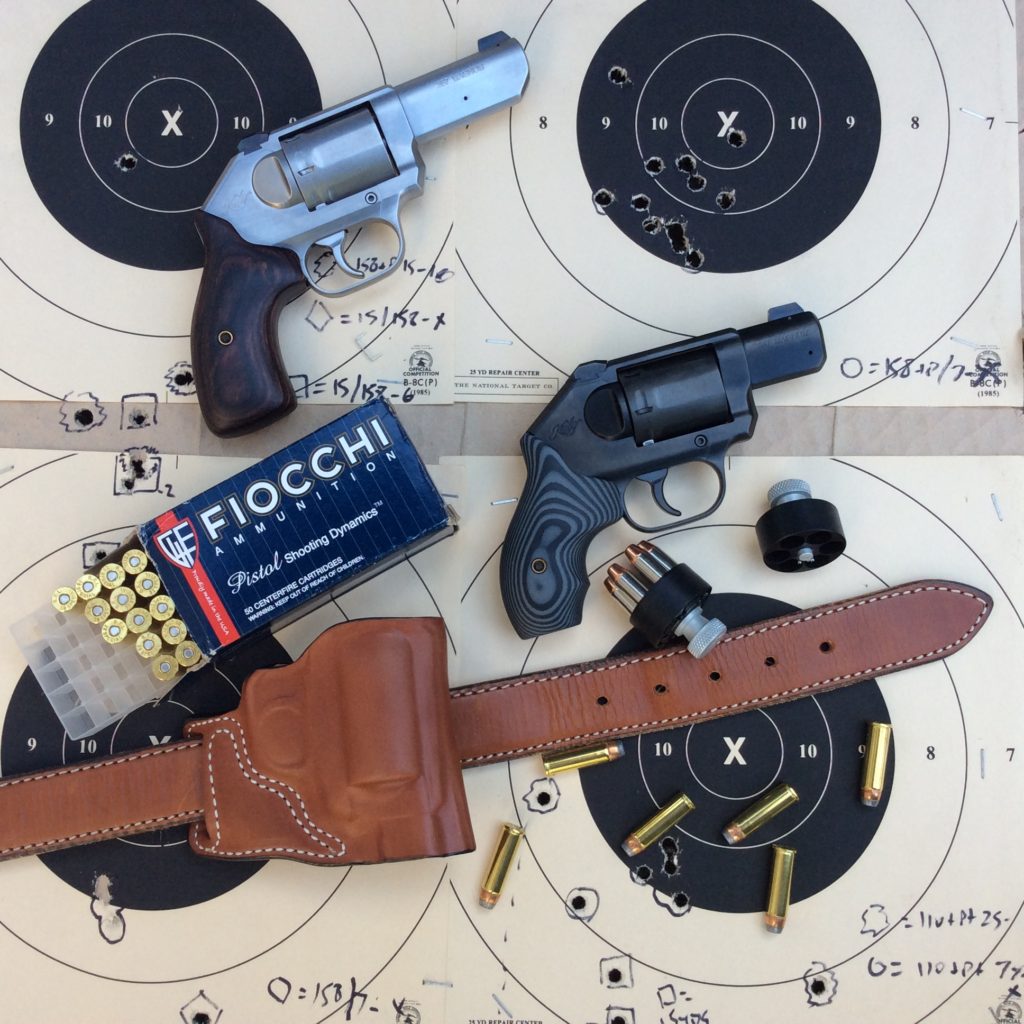 Light loads, heavy loads, fast ones, slow ones, long barrels, short barrels . . . the only way to know how it all ads up is to shoot and measure!
Light loads, heavy loads, fast ones, slow ones, long barrels, short barrels . . . the only way to know how it all ads up is to shoot and measure!
The truth is, we won’t know until you shoot it. The ammunition change has the potential to influence a whole bunch of factors at once, such as dwell time, felt recoil, and your control of the gun, and we won’t see the net result of all those changes until we add them up.
Consider another example, where you shoot the same load in two different guns—one an airweight snub, and the other a steel frame middleweight with a 4” barrel. How will the different characteristics of those guns (including grip size, grip shape, barrel length, total weight, sight coloration and texture, etc.), and the felt recoil generated in those guns, influence the POI of your chosen load? Again, we won’t know until you shoot it. There’s too many variables to account for, so we just have to plug them all in and run the equation to get the solution.
TRICKS OF THE TRADE
Each of the manufacturers has their own standards for sight regulation, which can throw a wrench in the works, too. Company “X” might build their guns so that the sights on their small frame guns are regulated to hit point of aim with a particular load at 25 yards, while the sights on their medium and large frame guns are regulated to hit point of aim with the same load at 75 yards.
Their competitor might use 15 yards as the baseline for their small guns and 50 for the bigger ones, and they might use an entirely different bullet weight and velocity to determine how tall their front sight needs to be.
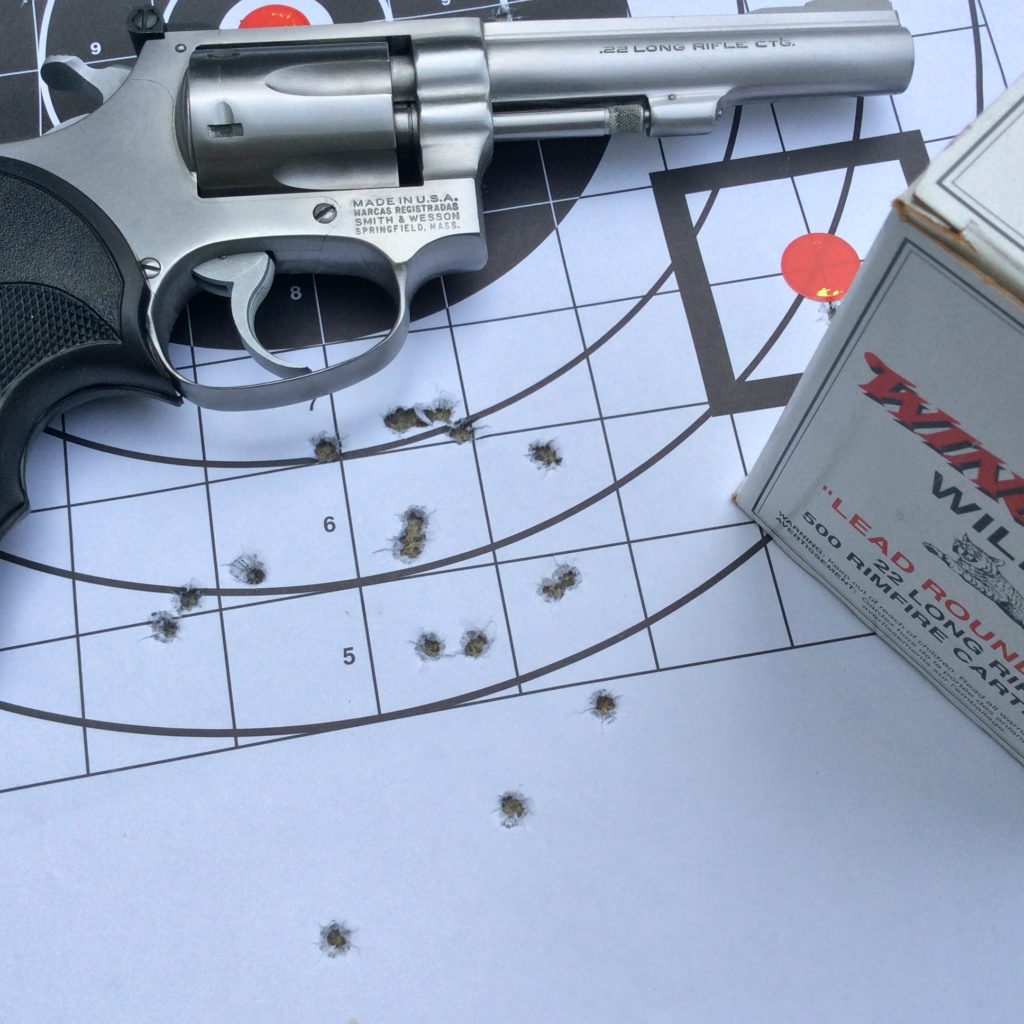 With the rear sight lowered, this Smith and Wesson Model 63 printed quite low at 15 and 25 yards . . .
With the rear sight lowered, this Smith and Wesson Model 63 printed quite low at 15 and 25 yards . . .
So, if you’ve got a gun from each company, you’ll likely need to shoot different loads to get them to hit anywhere close to each other at a given distance. One gun might require a slow and heavy bullet, and one might require a fast and heavy one to print within a few inches of each other at 25 yards, even though they’re both fixed sight, medium frame guns with 4” barrels.
Not only are standards variable throughout the industry, but sometimes they don’t make a lot of sense. A manufacturer might pick an unreasonable distance for the standard, or an unreasonable load for the gun.
For instance, a featherweight, “unobtanium” snub revolver might be regulated for 25 yards or more, even when the heart of its operational envelope is less than half of that. That same gun might have sights that are regulated for 158 grain, .357 Magnum stompers traveling over 1,400 fps, when every mortal being is going to load them with .38 Special lightweights, traveling at 850 fps (and will still complain about the recoil).
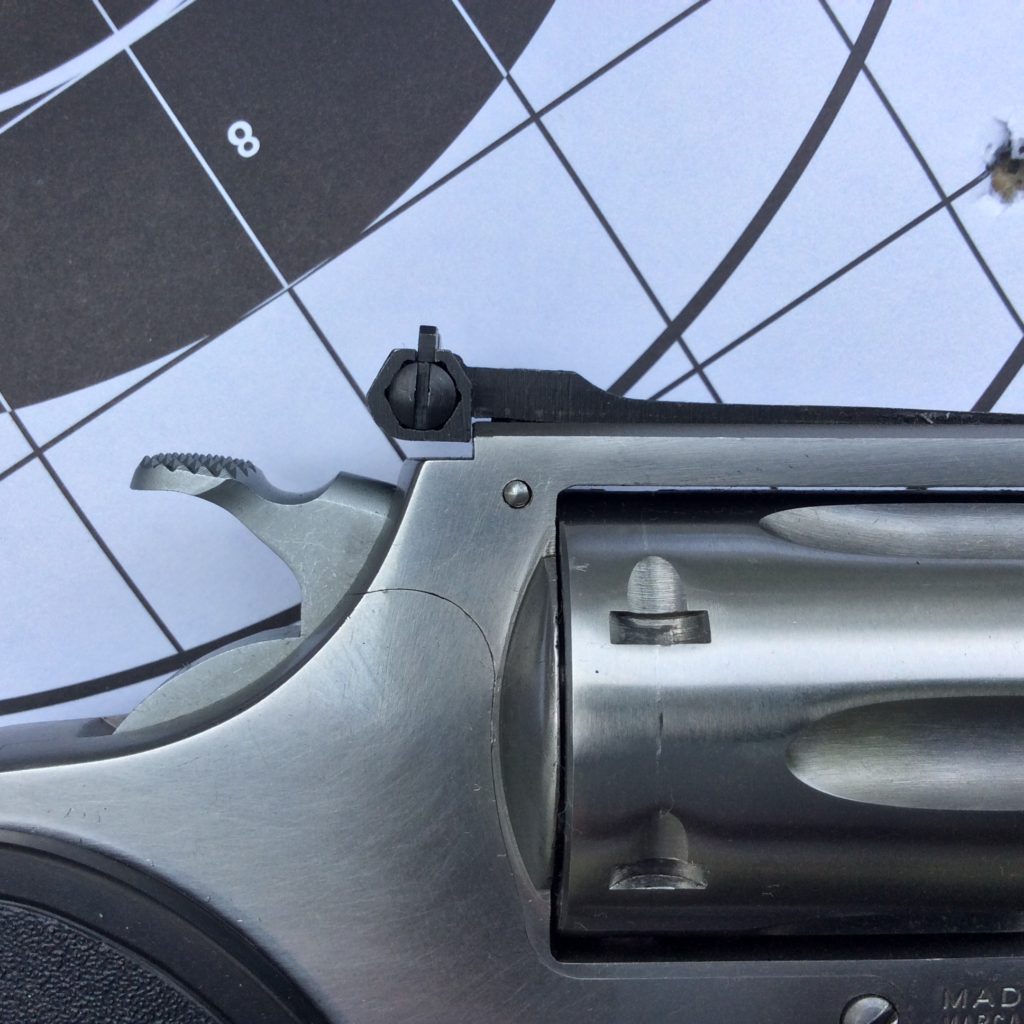 . . . requiring a large correction to the rear sight to raise the POI. If this had been a fixed sight gun, we’d try to solve the problem with different ammunition before we broke out the file!
. . . requiring a large correction to the rear sight to raise the POI. If this had been a fixed sight gun, we’d try to solve the problem with different ammunition before we broke out the file!
You don’t know the standards, and even if you did, they might not make sense anyhow. Are you starting to see why it’s hard to predict what your ammo will do in your gun at various distances?
GET BUSY
So, in the end, there’s no avoiding a bit of homework to see what your gun likes and doesn’t like. You’re going to have to hit the range with some paper targets, a notebook, a variety of ammo, and some patience to find a good solution for your gun. You’ll have to shoot and compare at a variety of distances, and make some choices.
If you’ve got an adjustable sight model, you might have to get busy with a screwdriver. If you’ve got a fixed sight model, you might have to break out a stone or a file and make some careful corrections, or just commit some holdoffs to memory, if you want to put your BBs in the right place on the target. Such is the life of a RevolverGuy.
*****
ENDNOTES
1. Our rifle guys might be a bit confused here, because a rifle barrel usually starts at an inclined angle to the horizon. This is a function of the greater range that a rifle will be used at. Gravity has more time to do its work on a bullet that travels several hundred yards, so we have to account for it by raising the bore. The practical effects of gravity on trajectory are insignificant at traditional pistol ranges though—your revolver bullet simply won’t drop enough inside of 25 yards to require us to elevate the muzzle above the horizontal plane.
Thank you to our Patrons for making this possible! If you aren’t a Patron, Support RevolverGuy on Patreon!
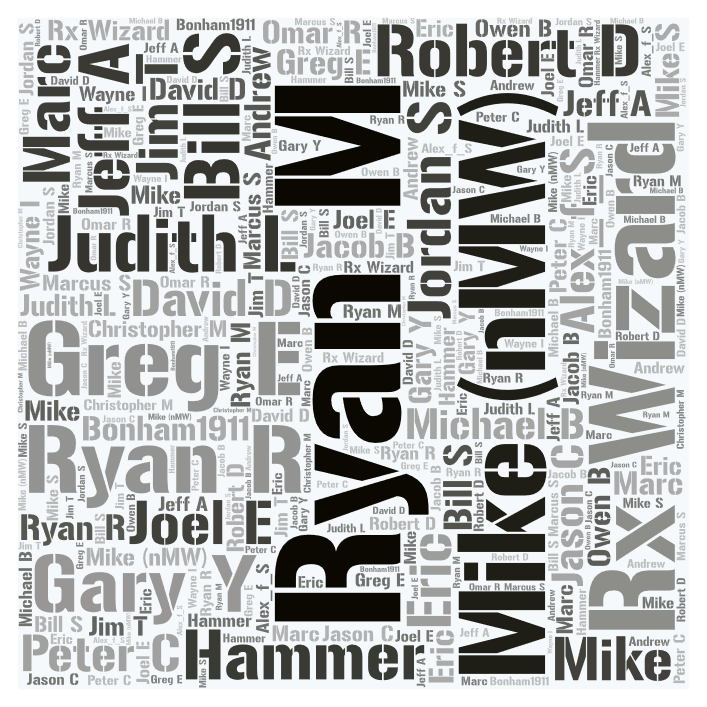

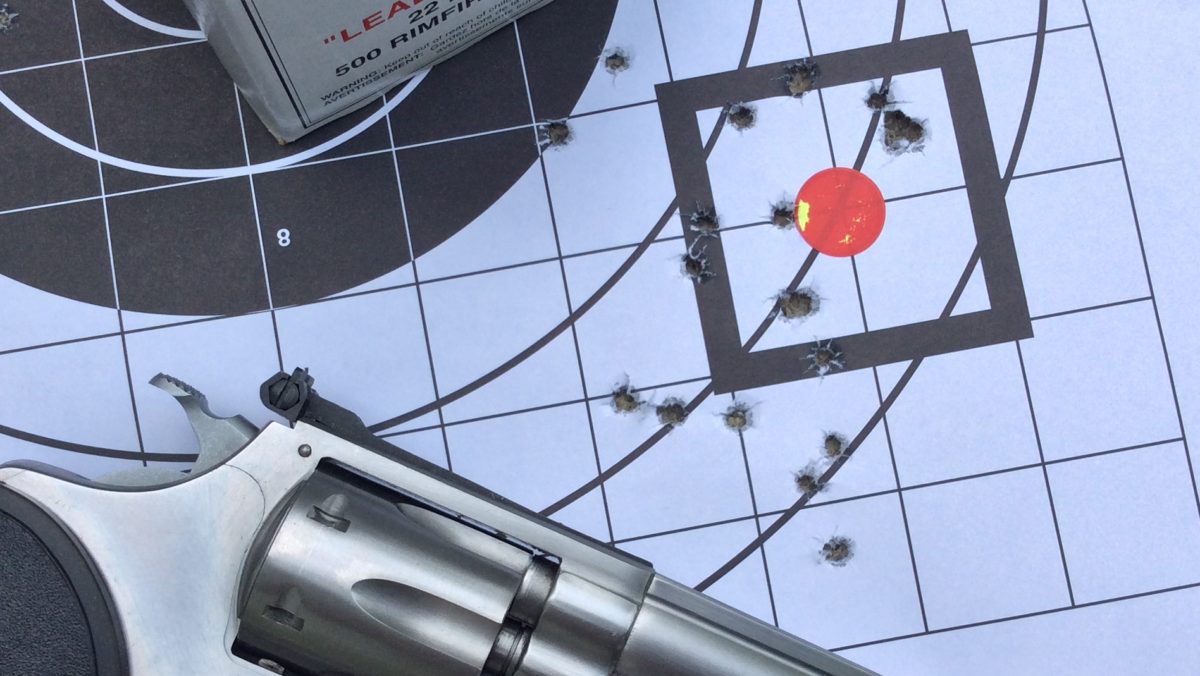
Thanks Mike,
Great information and well laid out. I have read and been told by gun shop people that slight differences between bullet diameter (all lead vs jhp/sjhp), forcing cone diameter, barrel/rifling diameter and how they all interact with each other can effect POA/POI. Any truth to this? If so, do you think it would be significant or be negligible? Or even what the effect could be?
Thanks again,
Mike (not, uh ….. you Mike Wood)
Hi Mike, I think there’s definitely some possibilities there. Consider a projectile that’s undersized for a bore—the rifling wouldn’t stabilize it as well, and the barrel would throw it unpredictably. On the opposite end, a projectile that was oversized would get squished and elongated (perhaps irregularly), making it fly differently than a projectile that wasn’t deformed. Same for a forcing cone that damaged the projectile before it went into the bore (due to tolerances, or bad cylinder timing).
An all lead projectile would obturate better, and fill the bore if it was undersized, but a jacketed projectile might not, so bullet construction could definitely play into it as well.
So many variables at play! It’s really amazing that everything comes together so nicely in most cases, when you think about it. The key is consistency, so a single change (in projectile construction, size, weight, etc.) can make a distinct difference. I think we see this in .22s a lot—they seem to be more sensitive to ammo choice than most other guns.
Mike (signing off to you, not me, even though I do talk to myself sometimes)
Good explanation.
I’ve been fortunate that enough of my guns in .38 and .357 have similar enough characteristics that I’ve had decent luck with them being close enough to each other with a given load. The 4″ SP101 does tend to have a lower POI than the 2″ version, but the adjustable rear sight (and probably the taller front sight) helps with that.
I’m kind of glad to see that you had to raise the rear sight on your Model 63 so far, because I had to do the same thing with my 317. At least I know it wasn’t *all* my shooting. I was actually on the verge of buying a taller rear sight blade until I tried CCI Mini-Mags and found that they didn’t require the sight to be adjusted as far.
Thanks Greyson. Yeah, I just about ran out of travel on that rear sight. S&W must regulate those guns at 2 yards or something like that! Thanks for the Mini Mag recommendation, I’ll try some of those.
Hmm, I never considered different lighting… It makes perfect sense though. Thanks Mike!
Riley, the rifle shooters have some kind of jingle they use to remember how to adjust their sights for the rise of the sun in the sky (“sun up, sights up,” or something like that—maybe a sharp reader can help me out, here) but I’m having a hard time remembering it right now. The idea is that when the sun is high in the sky, at midday, the top part of the front sight post tends to flare and reflect more light, which draws your eye to it. There’s a natural inclination to center your sight picture on that brightest spot, which can shift POI in elevation. I’ve experienced the same on ranges with a North-South orientation, where the morning sun illuminates one side of your sight post more than the other, causing a windage error when you center on the shiny half.
Indoor range lighting is often poor, and when your eyes start to age, it becomes even more difficult to make out the sights in the dim light. This often leads to POI errors that you wouldn’t see outdoors in natural lighting. Yet another reason that I prefer an outdoor range to an indoor one!
Oh yes, these last ten years or so I’ve been learning a whole new kind of challenge as my eyes age! Most interesting about the rifle saying, I’ll look into it.
I think I remember it now…”light’s up, sights up.” I knew it had a better rhyme to it.
Sights can work a bit like aircraft controls:
Control yoke comes back, houses get smaller
Control yoke goes forward, houses get bigger
Hold Control yoke back, houses get smaller, then disappear altogether, then reappear, then get BIGGER, fast.
Now I just need a good mechanic to fix the writeup I put in the logbook about the trigger actuator malfunctioning.
This post is so welcome. I find this part of shooting to be frustrating for many new to wheelguns.
In my case, I found the Kimber K6S 2” shot low with all rounds, though I figured it to be set up for 158 gr .357s. After much consternation and a lot of filing, I got it zeroed in a 20’, which to me is a good working range for a snub. Works well with my +p carry ammo or .357s now.
Grant Cunningham did superb work with the gun, overall. My gun is an early issue and has over 1k rounds through it now. Perhaps POA shooting improved with later guns.
Yes, I’m sure it took a LOT of filing to fix that K6s! My 2” DC is way off. Glad you got yours set up right. I don’t think Kimber listened to Grant’s advice on the sight regulation!
Old-school, I have a question for you. I have recently bought a K6s DCR that has a fiber optic sight that is impacting 3 inches low at my preferred distance of zero which is 7 yards with Hornady Critical defense 110 grain load.
In order for you to raise the impact location, did you file down the bottom or the top of the sight?
I contacted mepro light and they did not hesitate in offering to send me an RMR to send the K6s to them & they would file down the bottom of the sight for me to remedy the situation. They also said they might be able to find a completely different sight for me that would work.
I am having a trigger kit installed to lighten up the pull weight by a little bit. I have a trigger finger injury I sustained on my job 15 years ago that has reduced my strength that it makes it not impossible, but more difficult to work the double action.
While my gunsmith is doing the trigger kit, I could have him do the filing down of the sight for me, then test it for the amount that it raises as he increases the amount that he reduces. There is a range in. the same building that he works in.
Any suggestions would be appreciated.
This article has been bookmarked for future studies. I have read similar articles with this topic, just not nearly as clear as this one is. Salute.
John, I did an article on how I filed the top of my OEM sights to fix the same problem:
K6s Fixes and Mods
The problem with this method is that you can run into the dot on the front sight pretty quick. I was able to preserve the tritium lamp on my DC, but I came awfully close to it. I would have preferred to take a little more off the top, but wanted to save some material for structural integrity.
Taking material off the bottom of the sight is possible, but more tricky. The sight base has a tenon that goes into a recess, and a cross pin goes through it to secure the sight. With some careful filing, you can remove sight base material, and shorten the tenon, to get your desired height without affecting the dot. The rub is that you’ll have to drill a new hole for the cross pin, and if you haven’t shortened the sight enough, your new hole may overlap the old hole in the tenon, and the front sight will be sloppy. So, for best results, you’d have to weld up and fill the old hole, before drilling the new one.
It can be done. But as you can see, for the average hobbyist, it’s just easier to take a little off the top.
The fiber optic sights are more difficult to work with, because there’s less material on the top of the sight, above the pipe, that you can remove. You may be forced to take it off the bottom, or just find another sight height. If Mepro is willing to help you there, that might be the way to go.
FWIW, the early K6s sights were lower than current production, so if you can find an OEM early-style sight, it would probably help your elevation a lot, but it’s not a fiber optic.
Also, since you mentioned a trigger spring kit, this article about the TK Custom product might interest you:
TK Custom K6s Firing Pin and Spring Kit
Thx Mike!
Hello Old School. I am having the same issue as you had, impacts hitting 2-3 inches low @ 7 yards. I have the DCR with the fiber optic. Is that the same model that you have? If so, I would love to see a pic of the finished job. Any advice will be much appreciated. Thx U!
Outstanding article.
Thanks Dave! Great to hear from you!
A revolver bullet certainly has significant drop at normal handgun ranges… a 158 gr 38 spl bullet @ 800 fps drops about 2.3″ at 25 yds.
So, in order to match POI to POA at 25 yds with a sight height of 0.6″ your line of sight should be about 8.9 MOA up at the moment of bullet exit. As you have explained, the revolver arcs in recoil and the muzzle goes from pointing down while aiming to actually pointing up when the bullet exits the bore.
In the same example, if you are zeroed at 25 yds then your gun will print 0.2″ low at 5 yds, 0.2″ high at 15 yds, and from 25+ yds it will print low, not up. At 40 yds it will shoot about 1.3 low.
This example is from a ballistic calculator, but I’ve shot many revolvers fron point blank to 200+ m to see that agrees with what you would encounter in reality very well.
Thanks for crunching all the numbers and sharing them Ruben!
Great article as it explained many of the factors that goes in the differences between POA and POI. I would love to what can be done to fix windage issues on a revolver with combat (gutter) rear sights.
Thanks QG. Have you seen this article yet? It discusses solving windage problems:
Barrel Clocking Issues
When I was at Ruger fixed sight Service revolvers were targeted hand held off sandbags firing at a 2-inch aiming black at 20 yards. A 3-inch circle was drawn around the aiming point being tangent to the aiming point at 6:00. A ten board of guns would be shot for zero and front sights changed as needed to contain six rounds all within the 3-inch circle. For normal commercial production 158-grain lead standard velocity ammunition was used in .38 Special and 158-grain softpoint full-charge ammo in the .357s. Police contract guns would be targeted in accordance with contract requirements using ammunition provided as government furnished material. The great majority of guns had no trouble grouping within the old US Army standard of one inch per ten yards with ordinary service loads. With the best ammunition a master gunner could fire groups with all shots touching at 20 yards, even with the snubbies
Wonderful info! Thank you Sir!
Mike, a friend’s factory-reworked S&W Model 1917 chambered in .45 ACP has an almost freakishly tall front sight, to work with its shortened barrel. Your article does a great job of explaining why.
Glad it was helpful to you, Ricky. Welcome aboard!